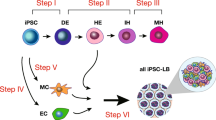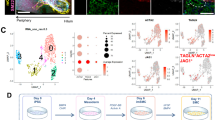Abstract
While in vitro liver tissue engineering has been increasingly studied during the last several years, presently engineered liver tissues lack the bile duct system. The lack of bile drainage not only hinders essential digestive functions of the liver, but also leads to accumulation of bile that is toxic to hepatocytes and known to cause liver cirrhosis. Clearly, generation of bile duct tissue is essential for engineering functional and healthy liver. Differentiation of human induced pluripotent stem cells (iPSCs) to bile duct tissue requires long and/or complex culture conditions, and has been inefficient so far. Towards generating a fully functional liver containing biliary system, we have developed defined and controlled conditions for efficient 2D and 3D bile duct epithelial tissue generation. A marker for multipotent liver progenitor in both adult human liver and ductal plate in human fetal liver, EpCAM, is highly expressed in hepatic spheroids generated from human iPSCs. The EpCAM high hepatic spheroids can, not only efficiently generate a monolayer of biliary epithelial cells (cholangiocytes), in a 2D differentiation condition, but also form functional ductal structures in a 3D condition. Importantly, this EpCAM high spheroid based biliary tissue generation is significantly faster than other existing methods and does not require cell sorting. In addition, we show that a knock-in CK7 reporter human iPSC line generated by CRISPR/Cas9 genome editing technology greatly facilitates the analysis of biliary differentiation. This new ductal differentiation method will provide a more efficient method of obtaining bile duct cells and tissues, which may facilitate engineering of complete and functional liver tissue in the future.




Similar content being viewed by others
References
Tietz, P. S., & Larusso, N. F. (2006). Cholangiocyte biology. Current Opinion in Gastroenterology, 22(3), 279–287. doi:10.1097/01.mog.0000218965.78558.bc.
Strazzabosco, M., & Fabris, L. (2012). Development of the bile ducts: essentials for the clinical hepatologist. Journal of Hepatology, 56(5), 1159–1170. doi:10.1016/j.jhep.2011.09.022.
Gouw, A. S., Clouston, A. D., & Theise, N. D. (2011). Ductular reactions in human liver: diversity at the interface. Hepatology, 54(5), 1853–1863. doi:10.1002/hep.24613.
Okabe, M., Tsukahara, Y., Tanaka, M., Suzuki, K., Saito, S., Kamiya, Y., Tsujimura, T., Nakamura, K., & Miyajima, A. (2009). Potential hepatic stem cells reside in EpCAM+ cells of normal and injured mouse liver. Development, 136(11), 1951–1960. doi:10.1242/dev.031369.
Tanimizu, N., & Mitaka, T. (2014). Re-evaluation of liver stem/progenitor cells. Organogenesis, 10(2), 208–215. doi:10.4161/org.27591.
Lee, S. J., Park, J. B., Kim, K. H., Lee, W. R., Kim, J. Y., An, H. J., & Park, K. K. (2014). Immunohistochemical study for the origin of ductular reaction in chronic liver disease. International Journal of Clinical and Experimental Pathology, 7(7), 4076–4085.
Lazaridis, K. N., & LaRusso, N. F. (2015). The Cholangiopathies. Mayo Clinic Proceedings, 90(6), 791–800. doi:10.1016/j.mayocp.2015.03.017.
Takayama, K., Inamura, M., Kawabata, K., Katayama, K., Higuchi, M., Tashiro, K., Nonaka, A., Sakurai, F., Hayakawa, T., Furue, M. K., & Mizuguchi, H. (2012). Efficient generation of functional hepatocytes from human embryonic stem cells and induced pluripotent stem cells by HNF4alpha transduction. Molecular Therapy, 20(1), 127–137. doi:10.1038/mt.2011.234.
Ma, X., Duan, Y., Tschudy-Seney, B., Roll, G., Behbahan, I. S., Ahuja, T. P., Tolstikov, V., Wang, C., McGee, J., Khoobyari, S., Nolta, J. A., Willenbring, H., & Zern, M. A. (2013). Highly efficient differentiation of functional hepatocytes from human induced pluripotent stem cells. Stem Cells Translational Medicine, 2(6), 409–419. doi:10.5966/sctm.2012-0160.
Choi, S. M., Kim, Y., Liu, H., Chaudhari, P., Ye, Z., & Jang, Y. Y. (2011). Liver engraftment potential of hepatic cells derived from patient-specific induced pluripotent stem cells. Cell Cycle, 10(15), 2423–2427.
Huch, M., Gehart, H., van Boxtel, R., Hamer, K., Blokzijl, F., Verstegen, M. M., Ellis, E., van Wenum, M., Fuchs, S. A., de Ligt, J., van de Wetering, M., Sasaki, N., Boers, S. J., Kemperman, H., de Jonge, J., Ijzermans, J. N., Nieuwenhuis, E. E., Hoekstra, R., Strom, S., Vries, R. R., van der Laan, L. J., Cuppen, E., & Clevers, H. (2015). Long-term culture of genome-stable bipotent stem cells from adult human liver. Cell, 160(1–2), 299–312. doi:10.1016/j.cell.2014.11.050.
Huch, M., Dorrell, C., Boj, S. F., van Es, J. H., Li, V. S., van de Wetering, M., Sato, T., Hamer, K., Sasaki, N., Finegold, M. J., Haft, A., Vries, R. G., Grompe, M., & Clevers, H. (2013). In vitro expansion of single Lgr5+ liver stem cells induced by Wnt-driven regeneration. Nature, 494(7436), 247–250. doi:10.1038/nature11826.
Krause, P., Unthan-Fechner, K., Probst, I., & Koenig, S. (2014). Cultured hepatocytes adopt progenitor characteristics and display bipotent capacity to repopulate the liver. Cell Transplantation, 23(7), 805–817. doi:10.3727/096368913X664856.
Ogawa, M., Ogawa, S., Bear, C. E., Ahmadi, S., Chin, S., Li, B., Grompe, M., Keller, G., Kamath, B. M., & Ghanekar, A. (2015). Directed differentiation of cholangiocytes from human pluripotent stem cells. Nature Biotechnology, 33(8), 853–861. doi:10.1038/nbt.3294.
Dianat, N., Dubois-Pot-Schneider, H., Steichen, C., Desterke, C., Leclerc, P., Raveux, A., Combettes, L., Weber, A., Corlu, A., & Dubart-Kupperschmitt, A. (2014). Generation of functional cholangiocyte-like cells from human pluripotent stem cells and HepaRG cells. Hepatology, 60(2), 700–714. doi:10.1002/hep.27165.
Sampaziotis, F., Cardoso de Brito, M., Madrigal, P., Bertero, A., Saeb-Parsy, K., Soares, F. A., Schrumpf, E., Melum, E., Karlsen, T. H., Bradley, J. A., Gelson, W. T., Davies, S., Baker, A., Kaser, A., Alexander, G. J., Hannan, N. R., & Vallier, L. (2015). Cholangiocytes derived from human induced pluripotent stem cells for disease modeling and drug validation. Nature Biotechnology, 33(8), 845–852. doi:10.1038/nbt.3275.
Choi, S. M., Liu, H., Chaudhari, P., Kim, Y., Cheng, L., Feng, J., Sharkis, S., Ye, Z., & Jang, Y. Y. (2011). Reprogramming of EBV-immortalized B-lymphocyte cell lines into induced pluripotent stem cells. Blood, 118(7), 1801–1805. doi:10.1182/blood-2011-03-340620.
Liu, H., Kim, Y., Sharkis, S., Marchionni, L., & Jang, Y. Y. (2011). In vivo liver regeneration potential of human induced pluripotent stem cells from diverse origins. Science Translational Medicine, 3(82), 82ra39. doi:10.1126/scitranslmed.3002376.
Liu, H., Ye, Z., Kim, Y., Sharkis, S., & Jang, Y. Y. (2010). Generation of endoderm-derived human induced pluripotent stem cells from primary hepatocytes. Hepatology, 51(5), 1810–1819. doi:10.1002/hep.23626.
Tian, L., Prasad, N., & Jang, Y. Y. (2014). In vitro modeling of alcohol-induced liver injury using human-induced pluripotent stem cells. Methods in Molecular Biology. doi:10.1007/7651_2014_168.
Choi, S. M., Kim, Y., Shim, J. S., Park, J. T., Wang, R. H., Leach, S. D., Liu, J. O., Deng, C., Ye, Z., & Jang, Y. Y. (2013). Efficient drug screening and gene correction for treating liver disease using patient-specific stem cells. Hepatology, 57(6), 2458–2468. doi:10.1002/hep.26237.
Chun, Y. S., Chaudhari, P., & Jang, Y. Y. (2010). Applications of patient-specific induced pluripotent stem cells; focused on disease modeling, drug screening and therapeutic potentials for liver disease. International Journal of Biological Sciences, 6(7), 796–805.
Tanimizu, N., Miyajima, A., & Mostov, K. E. (2007). Liver progenitor cells develop cholangiocyte-type epithelial polarity in three-dimensional culture. Molecular Biology of the Cell, 18(4), 1472–1479. doi:10.1091/mbc.E06-09-0848.
Ueno, Y., Alpini, G., Yahagi, K., Kanno, N., Moritoki, Y., Fukushima, K., Glaser, S., LeSage, G., & Shimosegawa, T. (2003). Evaluation of differential gene expression by microarray analysis in small and large cholangiocytes isolated from normal mice. Liver International, 23(6), 449–459.
Acknowledgments
This work was supported in part by grants from Maryland Stem Cell Research Funds (2013-MSCRFII-0170 and 2014-MSCRFF-0655) and by NIH (P30DK089502).
Author information
Authors and Affiliations
Corresponding author
Ethics declarations
Conflict of Interest
The authors declare no potential conflicts of interest.
Rights and permissions
About this article
Cite this article
Tian, L., Deshmukh, A., Ye, Z. et al. Efficient and Controlled Generation of 2D and 3D Bile Duct Tissue from Human Pluripotent Stem Cell-Derived Spheroids. Stem Cell Rev and Rep 12, 500–508 (2016). https://doi.org/10.1007/s12015-016-9657-5
Published:
Issue Date:
DOI: https://doi.org/10.1007/s12015-016-9657-5




